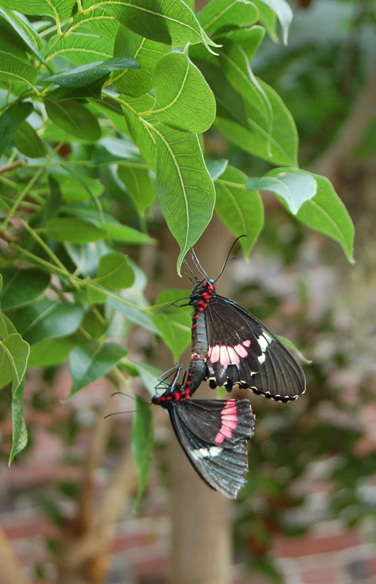In the fall of 2008, I took my three kids to the Museum of Science in Boston to see the live butterfly exhibit. Although we go to the Museum fairly often, we’d never been to the Butterfly Garden, and, for one reason or another, we’d finally decided to go. It was a cool trip. I now look at that day as the one on which I began making my way to Costa Rica.
How’s that?
Well, it started with the butterflies in the picture up there. Yes, they are mating. No, I am not some sort of butterfly pervert. I’m just a naturally curious girl! I’d done a little poking around online before our visit, and I knew that most butterfly exhibitors were not allowed to breed butterflies. And, yet, here were two Transandean Cattlehearts (I didn’t now they were called that then) … brazenly breeding for my camera.
What to do?
Well, I found me a Butterfly Garden Docent and pulled out my notebook. “What’s up with the mating butterflies?” I asked. “Isn’t that illegal?”
The Docent laughed, but in a very kind way. Then she explained that even though the butterflies were mating, the plant on which it relied for its larval food supply (that is, the only plant Transandean Cattleheart caterpillars could eat) was not growing in the garden. And so the female would most likely never lay her eggs. And if she did, they would be laid on a plant that could not support caterpillar growth. They could mate, but they would never produce a new generation of butterflies.
I was intrigued. I asked about four thousand more questions, and the kind people at the Butterfly Garden gave me four thousand more answers. They told me the most amazing things, among which was this doozy:
Every butterfly in that greenhouse had hatched from an egg on its natural host plant several weeks before … in Central America. They had lived their caterpillar lives there, and when they pupated, had been packaged up and mailed—by DHL, for crying out loud!—to the Museum. They were unpacked and incubated in a special behind-the-scenes laboratory, and when they finally emerged as adult butterflies, released into the garden for my kids and I to look at.
To this day, I find this astonishing.
So, on Monday, after more than a year of research and planning, I’m going on a little trip. I am going to live on a Costa Rican butterfly farm—one which supplies the Museum of Science with butterflies and which uses profits from those sales to preserve and protect the Costa Rican rainforest. I’m going to see with my own eyes how this amazing-ness unfolds. And when my camera is full and my notebooks are bulging and my head is ready to write, I’ll come home and begin the equally amazing process—at least to me—of sharing what I’ve seen.
See you soon!


